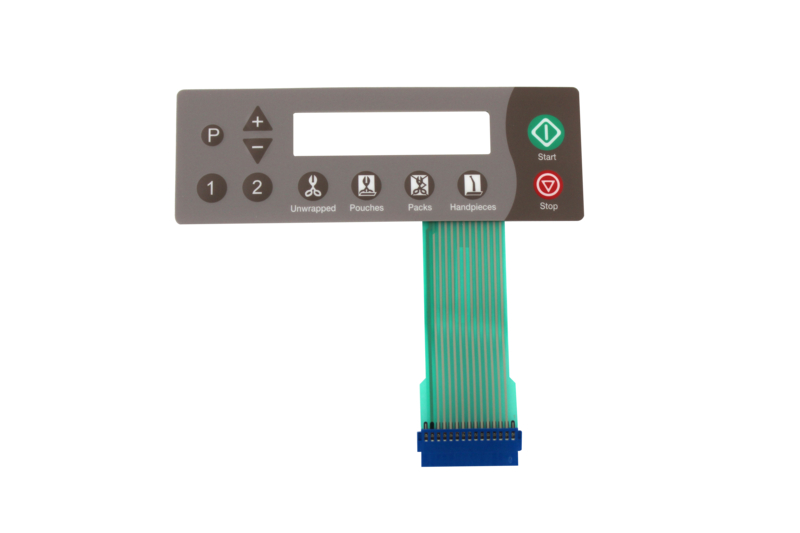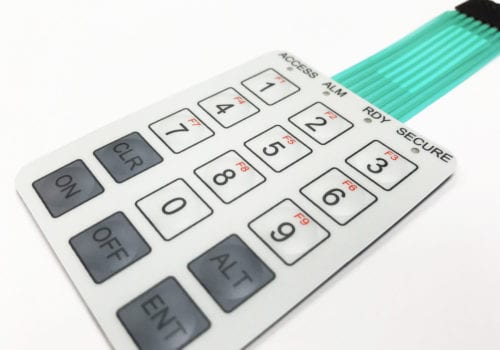Product testing is a top concern when selecting a membrane switch manufacturer for custom devices.
Product testing is a top concern when selecting a membrane switch manufacturer for custom devices.
Blog Article
What to Look for When Choosing a Membrane Layer Switch for Your Project
When you're choosing a membrane button for your job, numerous key variables come into play. You'll need to assume regarding the materials, design, and how well it aligns with your brand.
Recognizing Membrane Layer Switch Elements
When you plunge into the globe of membrane layer buttons, it's vital to realize the essential components that make them work. The button normally is composed of three major layers: the graphic overlay, the spacer layer, and the circuit layer. The graphic overlay offers the aesthetic user interface, presenting switches and icons you require for easy navigation. Underneath that, the spacer layer guarantees there's adequate range in between the circuit and the overlay, enabling the switch to turn on without constant pressure.
Recognizing exactly how these layers function with each other assists you select a membrane layer button that's trustworthy and fits your task demands. Pay close attention to the density and product of each layer, as these elements affect sturdiness and capability in numerous settings.
Material Option and Its Influence
Choosing the appropriate products for your membrane layer button can considerably influence its performance and longevity. The choice of substratum, typically polyester or polycarbonate, affects sturdiness and adaptability. Polyester is extra abrasion-resistant, while polycarbonate supplies far better quality and strength.
Following, take into consideration the adhesive. It needs to endure ecological aspects like dampness and temperature changes. A strong adhesive guarantees that your membrane layer button stays undamaged in time.
Do not forget the graphic overlay. The printing technique used, whether silkscreen or digital, affects the switch's aesthetics and longevity. High-grade inks will stand up to fading and scraping, maintaining a specialist look.
Last but not least, assume regarding environmental problems. If your tool will certainly be exposed to severe chemicals or severe temperature levels, pick materials made to endure these difficulties. Your choices in products will ultimately determine the button's dependability and individual satisfaction.
Style Factors To Consider for User Experience
Picking the appropriate materials lays the foundation for an effective membrane layer switch, however the layout also plays a significant duty in user experience. You'll desire to assess exactly how the design affects functionality (membrane switch manufacturer). Maintain buttons and icons user-friendly and well-spaced, making it easy for users to browse without complication

Color and contrast are likewise necessary; guarantee that your design is aesthetically appealing but still practical. High contrast helps individuals quickly identify switches, especially in low-light problems.
Finally, mirror on the overall visual. A streamlined and modern design can elevate individual assumption and make your item extra enticing. Stabilizing performance with an appealing layout will certainly result in a better customer experience and inevitably, an extra successful product.

Ecological Variables and Sturdiness
When choosing a membrane switch, you require to think about exactly how it'll do in numerous environments. Elements like temperature resistance, wetness and chemical exposure, and mechanical wear can substantially affect its sturdiness. Understanding these components will help you pick a switch that stands up to your particular problems.
Temperature Level Resistance Demands
As ecological problems can differ extensively, understanding temperature resistance is vital for guaranteeing the toughness of your membrane layer switch. You need to examine the temperature level range in which your gadget will operate. Heats can cause products to degrade, resulting in failing, while low temperature levels may make parts breakable and susceptible to cracking. Make certain to check the specifications of the products used in the switch, like the sticky and overlay, as they directly influence performance. It's additionally a good idea to consider potential temperature changes and their impacts on the button's reliability. By picking a membrane layer button with adequate temperature level resistance, you'll enhance its life-span and preserve performance in tough atmospheres. Choose sensibly to prevent pricey replacements down the line.

Moisture and Chemical Exposure
Moisture and chemical direct exposure can substantially affect the performance and long life of your membrane button, so it's important to understand the setting in which it will be used. If your project includes high humidity or exposure to fluids, look for protective coatings and sealants that can enhance resistance to moisture. Additionally, consider the sorts of chemicals your switch may come across. Specific materials can degrade when exposed to solvents, oils, or extreme cleansers. Selecting the best products, like polycarbonate or polyester, can aid stand up to these components. Always speak with the producer's specs for chemical compatibility to guarantee your membrane switch maintains its capability over time. By prioritizing moisture and chemical resistance, you can enhance the durability of your button in difficult environments.
Mechanical Use and Tear
While you may focus on functions like appearances and performance in your membrane switch, mechanical wear and tear can considerably impact its efficiency over time. Regular pressing can lead to deterioration of products, creating problems like tactile responses loss or even switch failure. Picking a durable button guarantees durability and dependability, avoiding expensive substitutes and downtime in your job.
Personalization Options for Branding
When it comes to branding your membrane layer switch, customization alternatives are key. You can select style elements and shades that show your brand name, in addition to specific logo positioning and size to boost visibility. Additionally, choosing the appropriate materials and appearances can boost the overall feel and look, making your item attract attention.
Layout Components and Shades
A vast range of layout components and shades can make your membrane button not simply practical yet additionally aesthetically appealing, enhancing your brand name identification. When choosing shades, consider your brand name's scheme; they need to resonate with your target market and stimulate the best emotions. You can additionally discover different finishes like matte or glossy to create different visual effects. Don't ignore structures; adding a tactile element can improve individual experience and check make your button stick out. Think about integrating personalized graphics or patterns that line up with your brand name message. By attentively selecting style components and colors, you not just produce a product that looks great yet additionally strengthens your branding consistently and efficiently.
Logo Placement and Dimension
After completing your design components and colors, the next step is to concentrate web on logo design positioning and size. Your logo is an essential aspect of your branding, so you'll desire it to stand apart without frustrating other layout components. Review where your logo will certainly be most visible and impactful; usual placements consist of the top or facility of the switch.
Consider the size as well-- as well large and it may outweigh functional components, too small and it could obtain lost. Go for an equilibrium that permits your logo to be easily well-known while keeping the general looks. Don't forget to consider exactly how the logo aligns with customer communication. This focus to information will certainly improve both performance and brand name identity in your project.
Material and Texture Options
Picking the best materials and appearances for your membrane layer switch can considerably enhance both its performance and visual appeal. You'll intend to examine options like polyester or polycarbonate, as they offer sturdiness and resistance to wear. The appearance of the surface additionally plays a necessary function; smooth finishes supply a sleek look, while textured surface areas can improve hold and responsive responses.
Personalizing the materials and structures allows you to reflect your brand identification efficiently. You may pick a matte surface to communicate elegance or a shiny look for a contemporary touch. Do not forget shade options, as vivid hues can make your button stand out, while soft tones can produce an extra classy appearance
Price vs. Quality: Discovering the Right Equilibrium
When you're taking care of the choices for membrane switches, stabilizing price and top quality can really feel frustrating. A lower-cost button may conserve you cash upfront, but if it endangers capability, you can face higher replacement costs later.
Search for suppliers that offer a good mix of price and high requirements. Research their track record and consumer testimonials to evaluate dependability. In some cases, investing a bit more in you can try here high quality materials can save you from future headaches.
Also, take into consideration the lasting performance and warranty options. A somewhat a lot more costly switch with a strong service warranty can confirm to be a smarter financial investment. Eventually, it has to do with locating that sweet spot where you meet your spending plan while guaranteeing your task's success.
Testing and Quality Guarantee Protocols
While you may locate the excellent membrane layer switch design, assuring its high quality with strenuous screening methods is essential for long-term success. Begin by verifying that the manufacturer follows industry criteria, such as IPC/WHMA-A -620, to assure a reliable product. membrane switch manufacturer. You'll want to examine for detailed testing approaches, consisting of environmental, mechanical, and electrical analyses
Ensure the buttons undergo resilience screening, simulating real-world usage to recognize any possible failures. Focus on the manufacturer's high quality guarantee process, which ought to consist of regular assessments and audits.

Don't fail to remember to request examples and conduct your own tests to confirm compatibility with your job. Ultimately, think about just how usually the manufacturer updates their protocols; advancement in screening can bring about improved quality. By prioritizing these testing and quality guarantee procedures, you'll increase the probability of an effective and long lasting membrane layer button for your application.
Regularly Asked Questions
For how long Does a Membrane Layer Change Commonly Last?
A membrane layer button normally lasts anywhere from 1 to 10 million cycles, depending upon use and environmental elements. You'll want to think about your details demands to guarantee it fulfills your durability requirements effectively.
Can Membrane Layer Switches Over Be Repaired if Harmed?
Yes, you can in some cases repair membrane layer buttons if they're damaged, yet it commonly depends on the degree of the damages. Minor problems could be reparable, while much more significant damage typically requires replacement for correct capability.
What Are the Typical Applications for Membrane Buttons?
Membrane buttons are typically utilized in home appliances, clinical tools, and automotive controls. You'll discover them in consumer electronic devices, industrial equipment, and even gaming consoles. Their convenience makes them suitable for various customer interfaces and atmospheres.
Are There Certain Accreditations for Membrane Layer Switches?
Yes, there specify qualifications for membrane buttons. Look for UL, CE, and RoHS accreditations to guarantee security and conformity. These certifications show the button meets market criteria for quality and environmental safety and security.
How Do I Make Sure Correct Installation of a Membrane Switch Over?
To assure proper setup of a membrane layer switch, tidy the surface area thoroughly, align it very carefully, and use also pressure. Adhere to supplier guidelines for sticky curing time to optimize durability and performance.
Conclusion
When choosing a membrane layer button for your task, maintain these essential aspects in mind: prioritize long lasting materials, focus on easy to use design, and take into consideration customization for your brand. By carefully evaluating these facets, you'll guarantee your membrane button not only meets your project needs but also improves individual experience and shows your brand identification properly.
Report this page